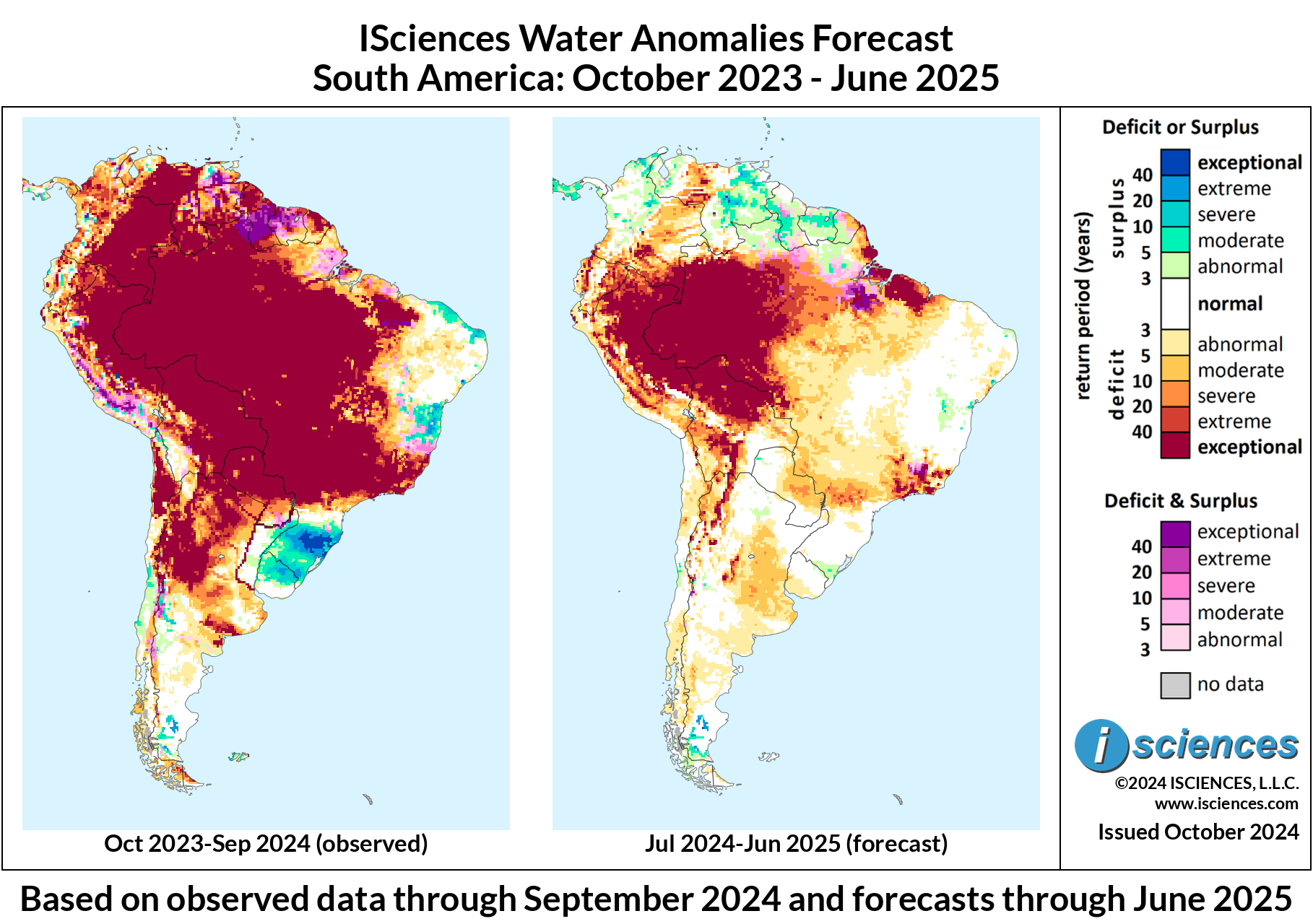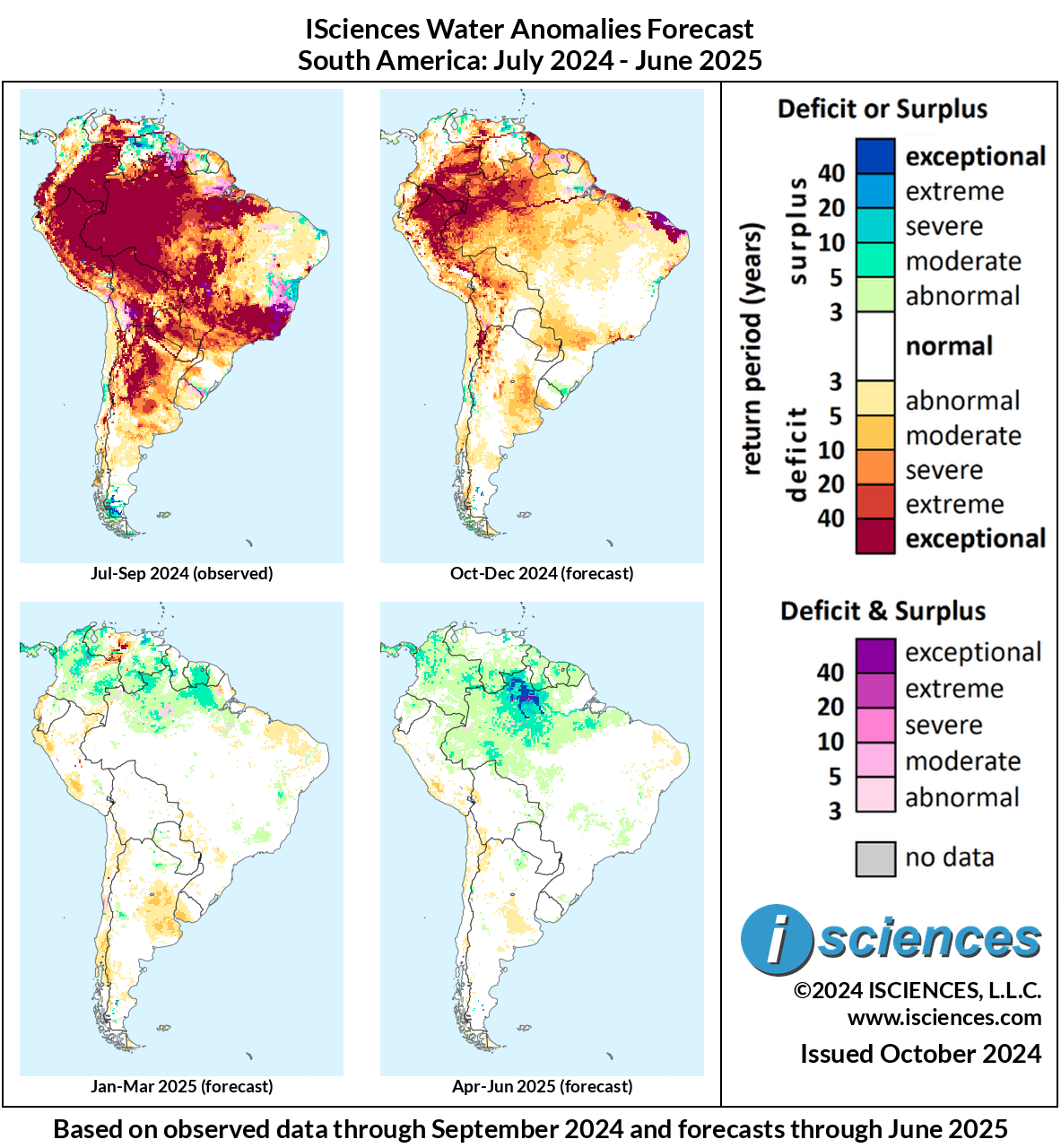South America: Widespread deficits continue throughout Amazon, Bolivarian Nations
21 October 2024
THE BIG PICTURE
The forecast ending in June 2025 indicates that exceptional deficits widespread throughout South America will persist in the Amazon and in the Bolivarian Nations. Several coastal regions of Brazil will also experience exceptional deficits.
Severe to exceptional deficits are anticipated in:
Western Brazil, throughout the states of Amazonas, Acre, and Rondonia. These deficits continue into much of Peru.
Northeastern coastal regions of Brazil, in the states of Para and Maranhao. These deficits also appear in southeastern coastal regions of Sao Paulo and Rio de Janeiro.
Bolivia, widespread throughout northern, central, and southern areas of the country.
Western coastal regions of Ecuador.
Northwestern Chile, near Salar de Arizaro Lake.
Severe to exceptional surpluses are expected in:
Eastern Venezuela, in the municipalities of Maturin and Bolivar.
Central regions of the Guianas.
Northwestern coastal regions of Colombia.
Southern Chile, in southern areas of the Santa Cruz province.
The 3-month maps (below) show the evolving conditions in more detail.
FORECAST BREAKDOWN
The forecast through December 2024 predicts that exceptional deficits will persist in northwestern Brazil, northern to eastern Peru, eastern Ecuador, and in central to southeastern regions of Colombia. Extreme to exceptional deficits are expected to occur in west-central Venezuela, northern coastal regions of Guyana, and along coastal areas of the Brazilian states of Maranhao, Ceara, and Rio Grande do Norte.
Extreme to exceptional deficits are also expected to be present in coastal regions of Rio de Janeiro and Espírito Santo. Further south, west-central and central regions of Bolivia will observe severe to extreme deficits, as will regions of northwestern Chile and northeastern Argentina. Exceptional deficits may also be present near Salar de Arizaro Lake.
From January through March 2025, exceptional deficits are expected to dissipate in northwestern countries. Moderate surpluses are expected in northern Brazil, Suriname, western Guyana, and portions of eastern Venezuela.
The forecast for the final months – April through June 2025 – indicates that moderate surpluses will continue in Brazil, Colombia, and portions of the Guianas. Exceptional surpluses may arise within areas of Roraima and eastern Amazonas.
Please note that WSIM forecast skill declines with longer lead times.
IMPACTS
Water levels of the Amazon River in the city of Manaus recently reached its lowest level since 1902. Manaus, the largest city in the Amazon rainforest, relies on the waterways for transportation of grain exports and basic supplies for locals. In the midst of consistently low rainfall and intense drought, scientists predict that the region will not experience normal moisture levels until 2026.
Smoke from wildfires have engulfed large areas of South America, including Ecuador’s capital, Quito, Paraguay’s Chaco forest, and the backlands of the Amazon rainforest. In Rondônia, the smoke is so thick that passenger planes have been unable to land in Porto Velho, the state’s capital. Dr. Lilian Samara de Melo Lima reported a surge of patients suffering from migraines, respiratory issues, and eye inflammation. “These days we can’t even see the other bank of the river,” she continued.
In rural communities in the Andes of Colombia and Ecuador, locals are fighting to protect the local wetlands from deforestation. These high-altitude wetlands, called paramos, regulate water cycles by absorbing and slowly releasing rain, and are primarily found in the Andes. Both countries are experiencing drought conditions caused by El Nino and have implemented power and water rationings to combat shortages.
NOTE ON ADMINISTRATIVE BOUNDARIES
There are numerous regions around the world where country borders are contested. ISciences depicts country boundaries on these maps solely to provide some geographic context. The boundaries are nominal, not legal, descriptions of each entity. The use of these boundaries does not imply any judgement on the legal status of any territory, or any endorsement or acceptance of disputed boundaries on the part of ISciences or our data providers.
Subscribe to our monthly Water Watch List
Search blog categories
- *Precip/Temp Outlooks 101
- *Press Releases 1
- *Special Topics 21
- *Water Watch Lists 121
- Africa 130
- Australia & New Zealand 114
- Canada 116
- Central Asia & Russia 114
- East Asia 115
- Europe 121
- Impact Highlights 1
- Mexico & C. Amer. & Carib 119
- Middle East 124
- Proof Point 2
- South America 130
- South Asia 120
- Southeast Asia & Pacific 123
- United States 120
Search blog tags



